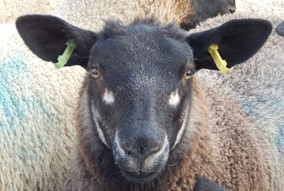Breeding Indexes
Signet Breeding Services produces several different breeding indexes
| Index | Main breeds using the index |
| Terminal Sire Index | Charollais, Hampshire Down, Meatlinc, Poll Dorset, Suffolk, Texel and Vendeen |
| Maternal Index | Charmoise Hill, Lleyn, Romney, Exlana, Easycare and Wiltshire Horn |
| Longwool / Crossing Index | Blue Faced Leicester |
| Hill Index | Scottish Blackface, North Country Cheviot and Welsh hill breeds such as Beulah, Welsh Mountain and Welsh Hardy Speckles |
Terminal Sire Index
The original terminal sire index, based on work by Simm and Amer was developed to select superior terminal sires with the aim of increasing the yield of lean meat in the carcase, while limiting any associated rise in fatness.
Weight data and ultrasonic measurements of muscle and fat depth were used to predict the total amount of muscle and fat in the carcase. Relative economic weightings of +3 and –1 are then applied to produce an overall index on which rams can be ranked.
In recent years the use of Computed Tomography has enabled breeders to directly measure the quantity of muscle and fat in the carcase. Further refinements saw penalties applied to the indexes of ultra-lean rams (with low fat depth EBVs) and a positive weighting on rams with superior gigot muscularity EBVs.
In 2019 the National Terminal Sire Evaluation was updated, with all carcase traits re-evaluated and moved on to a weight adjusted basis. The indexes used for Terminal Sire breeds were updated to take these changes into account. Read more.
Maternal Index
Maternal Breeding Indexes were designed to enhance lamb survival and pre-weaning growth rates by improving maternal ability. Maternal indexes are particularly useful within self-replacing flocks, where the number of lambs reared to weaning has a major impact on flock profitability.
Signet's maternal index places a high weighting on litter size, 8-week weight and maternal ability. Read more
Longwool Index / Bluefaced Leicester (crossing) Index
The original Longwool Index was designed to enhance the carcase quality of the longwool/crossing rams that are used for mating to hill ewes in the production of commercial crossbred ewes, like the mule.
The index aimed to enhance the financial productivity of these crossing sires. Increases in lamb growth rate were deemed important, but these increases were controlled so that ewe mature size did not become excessive. The index aimed to maintain prolificacy at current levels.
In recent years the index has been adapted to meet BFL ram breeder requirements.
The main EBVs included in the index remain
- Eight Week Weight
- Muscle Depth
- Maternal Ability
The Bluefaced Leicester index aims to highlight rams that will sire commercial ewes of an appropriate mature size that produce lambs with good growth rates and superior carcase conformation. Read more.
Hill Index
The original Hill Index was designed to enhance the overall productivity of the ewe by improving several traits simultaneously, most significantly the number of lambs successfully reared.
A new breeding index has been generated by Geneticist Janet Roden to aid breeders and buyers in the selection of the most profitable hill rams for commercial hill farming enterprises.
The index aims to enhance the performance of hill ewes, by:-
- Increasing lamb growth rates and carcase conformation
- Improving maternal performance in terms of milk production and maternal care
- Optimising the number of lambs reared on the hill
The new hill index aims to enhance the efficiency of hill ewes; making them more productive without increasing mature size and thus the cost of keeping them or compromising their survival or fitness in the hill environment. Read more.
